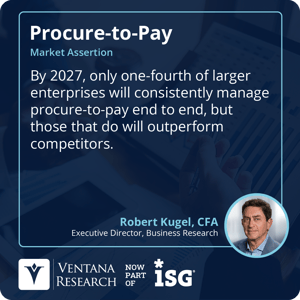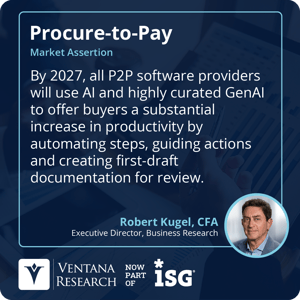Digitally transforming finance operations has been a priority since 2020. For purchasing and the procure-to-pay cycle, software can streamline processes, shorten process times, reduce unnecessary costs, provide greater visibility into cash flows, increase control and improve results. Digitizing operations helps attract and retain the best talent because professionals spend less time on mechanical, repetitive tasks. For all these reasons, beginning this year, Ventana Research’s Office of Finance has established a Procure to Pay focus area. One reason is that our research suggests that this transformation is more talked about than done. Ventana Research asserts that by 2027, only one-fourth of larger organizations will consistently manage procure-to-pay end to end, but those that do will outperform competitors.
Purchasing is a function overlooked for digital transformation because it’s too often viewed as a low priority. In most enterprises, this department continues to operate much as it did in the late 1990s. Updated technology – especially as software providers add artificial intelligence and generative AI capabilities – can improve procurement’s effectiveness, streamline processes and automate repetitive work.
the late 1990s. Updated technology – especially as software providers add artificial intelligence and generative AI capabilities – can improve procurement’s effectiveness, streamline processes and automate repetitive work.
In addition to increased efficiency, teams can better collaborate using their knowledge of products, vendors and markets to select and source the best materials, products and services from the most appropriate vendors. Technology can also improve the efficiency of the buying process while ensuring adherence to guidelines, controls and regulations. And technology can simplify the acquisition of indirect goods and services (such as computers and office supplies) while minimizing costs and controlling outlays.
Any transformation process begins with a critical gap analysis: What does the procurement function do now versus what could it be doing? Technology can act as the catalyst for recreating the department’s mission to serve the needs of the enterprise more effectively.
Digitally transformed purchasing departments can play a more active, productive role across the entire enterprise. For instance, based on their knowledge of markets and vendors, department specialists can advise R&D on technical developments and pricing trends that will affect product cost, functionality, durability, producibility and serviceability. In manufacturing and logistics, they can find ways to consolidate purchases to take advantage of volume discounts. Purchasing departments with marketing specialists who have developed digital advertising can assist product managers in developing modern, differentiated sales and marketing strategies.
On the indirect side, outlays account for a significant share of operating expense in many organizations. Transaction volumes can be heavy, so finance and accounting departments must often devote considerable time to transaction management and cost control. With the right technology and a repurposed purchasing department, a finance organization is better able to support complex innovation and go-to-market strategies. In addition, by automating indirect spend management, finance can reduce this administrative burden while improving compliance with policies related to indirect spend.
Finance and purchasing executives who want to transform their mission should recognize the important role software can play. By streamlining processes and reducing frictions that are inherent in manual systems, dedicated applications can make sourcing and procurement enablers rather than roadblocks for managers and employees.
In strategic purchasing, software that enables high adoption and usability can manage the entire process more effectively. It gives senior sourcing and procurement executives a full view of the portfolio of active and planned sourcing and procurement projects. Having a single, connected and centralized system with automated workflows for collaboration ensures that sourcing projects and requests are routed to the right individuals and handoffs between people and departments are always crisp.
Such a system also automates the handling of exceptions and escalations. Managers will have better visibility into their processes and more readily examine supplier relationships and contractual obligations. It can provide alerts when issues arise, such as processes falling behind schedule or when an approval needs to be escalated. Today’s applications must go beyond monolithic approaches focused mainly on compliance to add overall business value.
Collaboration between departments in strategic sourcing and procurement is essential. The best software enables cross-functional teams to share information quickly and efficiently, establish a record of their deliberations and store and access documents. Such a system gives all interested parties ready access to purchase information rather than forcing them to hunt through scattered spreadsheets and email messages. And consolidating all sourcing and procurement-related data in a dedicated system allows departments to analyze their performance more easily.
Outlays for individual purchases of indirect goods and services typically involve trivial amounts, but in many enterprises, they represent a significant share of controllable spend. Using a dedicated application for indirect spend management, especially in conjunction with payment cards, makes it easier to manage the high volume of indirect purchases. Software that automates the sourcing process makes it easier — and more enjoyable — for the business, stakeholders and vendors to comply with policies while making it easier for finance organizations to benefit from volume discounts and avert duplicative or unnecessary spending. It aggregates planning and sourcing data that otherwise may be scattered and inconsistent and automates data capture to ensure that spend data and analytics are not only accurate but immediately available to budget owners.
Artificial intelligence and generative AI will play a growing role in managing corporate spend. On the strategic side, and as part of its role in sales and operations planning, AI will facilitate the use of predictive analytics to improve the accuracy of demand forecasts and, potentially, reduce inventory and related carrying costs. Generative AI will be used to automate contract review and analysis by comparing terms, conditions and even specific clauses, improving compliance with enterprise standards while minimizing the risks that come with non-compliant contracts. The technology will automate the ingestion of paperwork, resulting in greater staff productivity from reduced manual effort, fewer associated accounting errors and more effective supplier management. Duplicate billing and even fraud will be detected by these systems.
AI won’t be a separate function, but integrated into procure-to-pay software. Ventana Research asserts that by 2027, all P2P software providers will use AI and highly curated generative AI to offer buyers a substantial increase in productivity by automating steps, guiding actions and creating first-draft documentation for review.
generative AI to offer buyers a substantial increase in productivity by automating steps, guiding actions and creating first-draft documentation for review.
A dedicated application adds value by quickly improving the efficiency and effectiveness of an enterprise’s sourcing and procurement. Automated workflows increase efficiency and enable departments to manage by exception. Greater efficiency means the entire organization spends less time on routine requisitioning and ordering. While ordering “by the book” is easy, organizations can achieve cost savings by concentrating purchases from authorized vendors, especially those where volume purchase agreements are in force, and ensure that invoiced prices and discounts match what’s in the contract. Accelerated improvements and quick wins give the rest of the enterprise the confidence that sourcing and procurement can adapt and prosper.
Software also enhances corporate effectiveness because the purchasing staff spends less time on routine work, leaving more time for them to act as a resource and support the complex sourcing of materials and services. This shift can enhance the quality of products and services enterprise offers. A dedicated system provides more thorough visibility into all direct and indirect spend because cash commitments are tracked from purchase order approval. This also reduces risk because such visibility enables scrutiny of future cash commitments and identifies bad actors in the sourcing and procurement process.
Digital transformation means shifting manual work – such as emailed spreadsheets – to software and systems. A practical approach to the transformation process is to undertake the change in a series of initiatives rather than a single, big-step overhaul. This approach is preferred because there’s usually limited staff time available for a singular focus on transformation. Moreover, a step-by-step approach enables departments to gather success metrics and apply lessons learned to better manage the transformation project. In determining the order of transformation projects, executives should prioritize those that will deliver a high payoff with limited risk. Sourcing and procurement are good places to start.
Investing in purchasing software can enhance the strategic value of the finance department. It makes it possible for the department to redefine its role as an enabler of better business outcomes. Digitizing purchasing with dedicated software supports this role while providing better control and visibility of corporate spending without needlessly encumbering the process. I recommend that chief financial officers, especially those with a purchasing department reporting to them, focus on digitizing the sourcing and purchasing functions.
Regards,
Robert Kugel


 the late 1990s. Updated technology – especially as software providers add artificial intelligence and generative AI capabilities – can improve procurement’s effectiveness, streamline processes and automate repetitive work.
the late 1990s. Updated technology – especially as software providers add artificial intelligence and generative AI capabilities – can improve procurement’s effectiveness, streamline processes and automate repetitive work.  generative AI to offer buyers a substantial increase in productivity by automating steps, guiding actions and creating first-draft documentation for review.
generative AI to offer buyers a substantial increase in productivity by automating steps, guiding actions and creating first-draft documentation for review.








